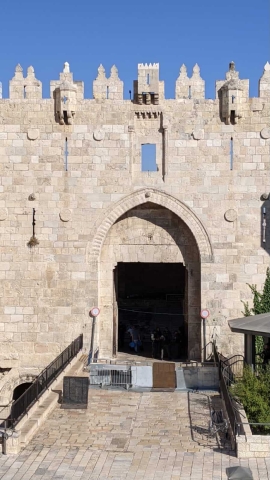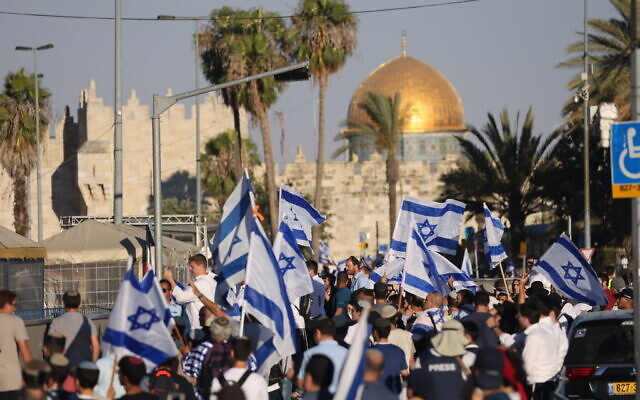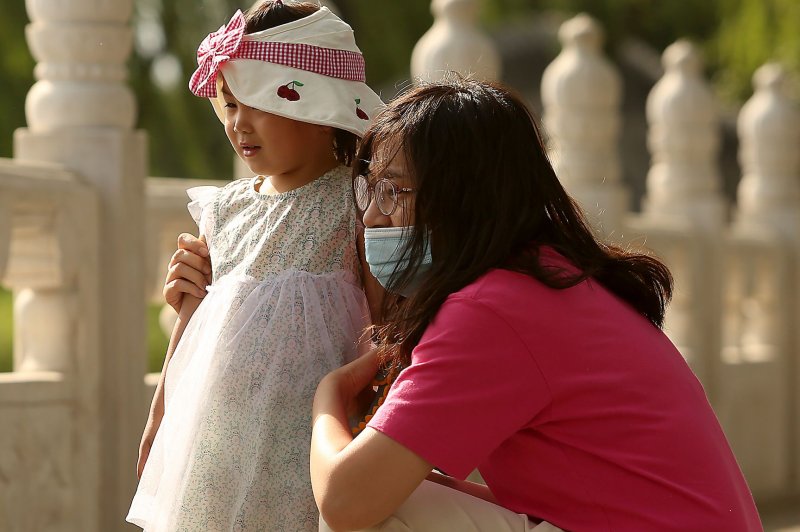Thousands of right-wing nationalists marched through parts of Jerusalem’s Old City on Tuesday under a heavy police presence, as Israeli security forces braced for possible fresh violence from Gaza amid threats from terror groups in the coastal enclave.
Police estimated turnout at 5,000 participants and some 2,000 officers were deployed across the city for the event.
Footage posted to social media showed the right-wing marchers chanting “Death to Arabs” as well as “Shuafat is on fire,” referring to the East Jerusalem neighborhood, and “Jerusalem is ours.”
While voicing support for the decision to approve the march, Foreign Minister Yair Lapid denounced the chants of “Death to Arabs.”
“The fact that there are extremist elements for whom the flag of Israel represents hate and racism is revolting and unforgivable,” Lapid tweeted. “It is incomprehensible that people can hold the Israeli flag in one hand and shout ‘Death to Arabs’ at the same time. This isn’t Judaism or Israeliness, and it is definitely not what our flag symbolizes. These people are a disgrace to the nation of Israel.
The parade, the first major test of the new government sworn in Sunday, was rescheduled after the original Flag March was halted on Jerusalem Day, May 10, when the Gaza Strip’s Hamas rulers fired rockets at Jerusalem.
As the march began just before 6 p.m., clashes broke out near the Old City between police and Palestinians, 33 of whom the Palestinian Red Crescent said it treated. Six of the injured were hospitalized for wounds from rubber or sponge-tipped bullets, according to the medical service, which also said another Palestinian was injured by live fire, but that police were preventing them from evacuating him for treatment.
Video showed Palestinians throwing rocks at mounted police officers and one fell off his horse.
Police arrested 17 people on suspicion of disturbing the peace, throwing rocks and assaulting officers. Two cops were injured and taken for medical treatment, according to police.
The clashes came as marchers gathered on Jerusalem’s Hanevi’im Street, from where they headed toward the Damascus Gate, a flashpoint in the Old City. As part of the route agreed upon with police, the marchers weren’t permitted to pass through the gate but could go past it, with some participants allowed to go down to the plaza just outside the gate.
The marchers then entered the Old City via the Jaffa Gate and marched toward the Western Wall.
A number of participants accosted Arab journalists, with a reporter sharing video showing marchers shouting curses at them, and one man spitting in their direction.
Some of the marchers chanted against Prime Minister Naftali Bennett and posters were seen depicting the new premier alongside the text “Bennett the liar.”
The posters apparently referred to Bennett’s breaking of his pre-election pledge not to form a government in which he switched off the premiership with Yair Lapid and not to rely on the Islamist Ra’am party’s support.
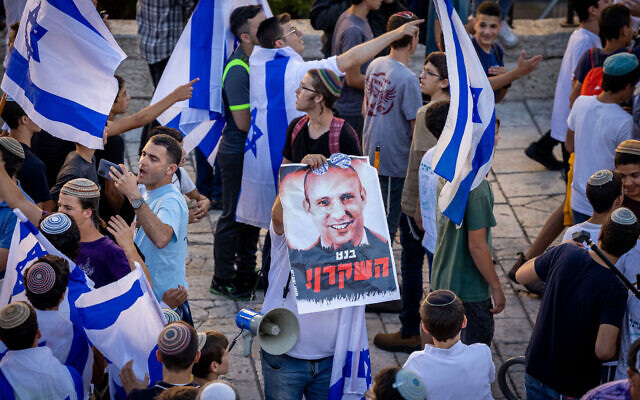
A poster reading ‘Bennett the liar’ is seen at the nationalist flag march, outside the Damascus Gate in Jerusalem’s Old City, June 15, 2021. (Nati Shohat/Flash90)
Several far-right lawmakers opposed to the government took part in the march, among them Religious Zionism leader Bezalel Smotrich and his faction’s lawmakers Itamar Ben Gvir and Orit Struck.
MKs May Golan and Shlomo Karhi of former prime minister Benjamin Netanyahu’s Likud party were also taking part, with video showing the latter dancing with Smotrich outside the Damascus Gate.
Lawmakers from the Joint List rallied outside the Old City to denounce the march, with the predominantly Arab political alliance’s leader Ayman Odeh saying that the Israeli capital will one day be the capital of a Palestinian state.
“On these walls the flag of Palestine will be hoisted and Jerusalem will be the capital of recaptured Palestine,” he told the Kan public broadcaster.
“Our people will cause them to be ashamed and withdraw from these places,” he said, referring to the Jewish marchers in the parade.

Nationalist Israel Jews wave Israeli flags as they march outside the Damascus Gate to Jerusalem’s Old City, on June 15, 2021. (Ahmad Gharabli/AFP)
Ra’am chief Mansour Abbas, whose Islamist party is part of the diverse ruling coalition, earlier called the march an “unbridled provocation” and said it should have been canceled.
Meanwhile, the Israel Defense Forces deployed Iron Dome missile defense batteries outside Jerusalem ahead of the march, according to Palestinian media reports. The IDF also deployed Iron Dome batteries elsewhere in the country and sent reinforcements to the West Bank.
Flight trackers showed air traffic to and from Ben Gurion Airport was being rerouted northward further away from Gaza to avoid any potential rocket fire.
The apparent precautions came as numerous blazes were sparked in southern Israel near Gaza, with fire services reporting at least 20 were sparked by balloon-borne incendiary devices launched from the Strip.
An explosive device attached to one balloon exploded over a kibbutz in the Sha’ar Hanegev Regional Council, startling children in a playground, according to Hebrew media reports. The children were said to have run to a bomb shelter after hearing the blast and there were no reports of injuries.
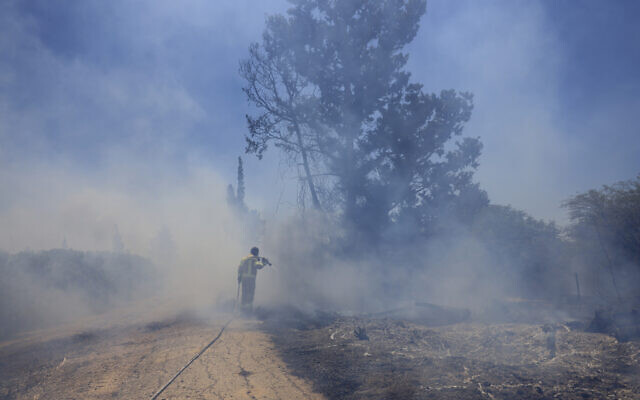
An Israeli firefighter attempts to extinguish a fire caused by an incendiary balloon launched by Palestinians from the Gaza Strip, on the Israel-Gaza border, Israel, June 15, 2021. (AP Photo/Tsafrir Abayov)
Clashes also broke out between dozens of Palestinian protesters and IDF troops on the Gaza border. One Palestinian was reportedly shot in the leg, suffering light injuries.
The IDF has been bracing for a resurgence in Gaza fighting and a flare-up of clashes across the West Bank following Palestinian threats of violence if the march went ahead.
Amid Tuesday’s violent incidents around Gaza, Channel 13 news cited unnamed Palestinian sources saying Egypt had asked Hamas not to cause an escalation, warning that such a move would “embarrass” Cairo and that Bennett’s government — which approved the parade on Monday — would respond forcefully.
According to the sources, Hamas responded that “all options are on the table” but escalation could be avoided “if the event doesn’t get out of control.”
Later in the evening, Channel 12 news said Israel warned Hamas via Egypt that it would there would be a tough and immediate response to any rocket fire from Gaza. The network quoted a diplomatic source vowing Israel would respond to the arson balloon attacks, but would pick the timing.
The report said Israel warned Hamas that any escalation in violence would jeopardize understandings on allowing goods into Gaza and improving conditions there that the Egyptians are trying to broker, while signaling it made efforts to ensure the march would not go through the Old City’s Muslim Quarter.
The network also asked the diplomatic source what Bennett would now do as prime minister in light of hawkish comments he has previously made.
“On the one hand there are doubts, we want to show that there really is a new equation here like we promised after Operation Guardian of the Walls,” the source said. “On the other hand, we don’t want to create the connection that Hamas wants us to create between Gaza and Jerusalem. There will be a response and it will be expressed in a variety of forms.”
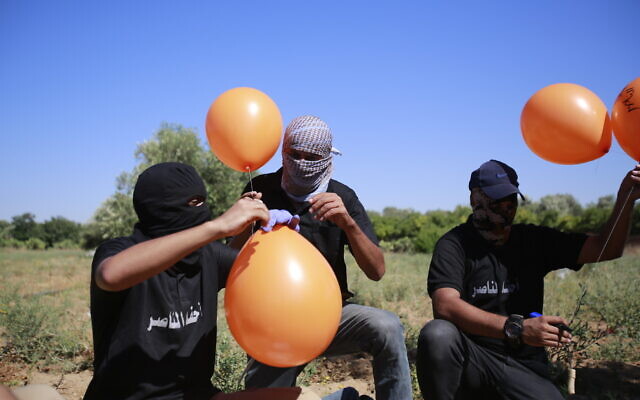
Supporters of the Palestinian Islamic Jihad terror group prepare balloon-borne incendiary devices to launch toward Israel, east of Gaza City, on June 15, 2021. (Atia Mohammed/Flash90)
The May 10 — Jerusalem Day — rocket attack during the original parade, which came amid already rising tensions over planned East Jerusalem home evictions and police actions against Muslim rioters on the Temple Mount, touched off 11 days of intense fighting between Israel and Hamas-led terrorists in the Gaza Strip, as well as a rash of lower-level clashes in the West Bank and mob violence between Arabs and Jews inside Israel.
Since the fighting ended, Hamas has repeatedly warned that it could reopen hostilities over developments in Jerusalem, and has responded with increased belligerence to plans for the march, an annual event — held to mark Israel’s 1967 capture of East Jerusalem — during which thousands of nationalist youths parade through the Muslim Quarter of the Old City toward the Western Wall.
The rescheduled event was initially planned for last Thursday, but was postponed to this Tuesday when police refused to authorize its planned route through the Old City’s Damascus Gate entrance and Muslim Quarter.






